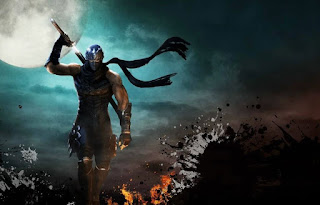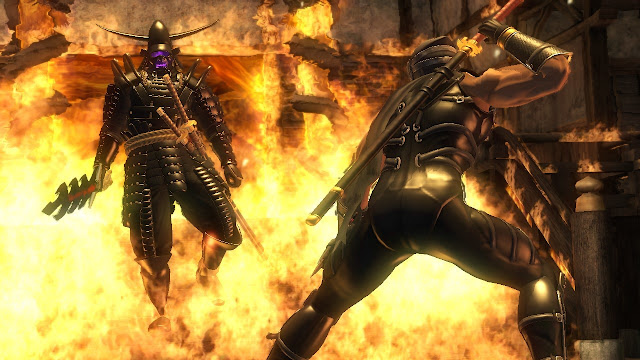The ninja has become an almost mythological figure within Japanese history and culture. In reality, they were actually reasonably mundane; the ninja “tradition” has been born of a combination of spies that the samurai would use to keep an eye on one another, and guerrilla warrior citizenry that would use whatever tricks and weapons they had to hand since they couldn’t access the elegant bows and swords that only the samurai was allowed to possess. And yet, because of their supposed ability to disappear in plain sight, run on water, and backstab from stealth like a true assassin – stories spread to help them maintain a fearsome reputation – the ninja has become legendary. Koei Tecmo’s Ninja Gaiden series has always been some of the best depictions of the mythical athleticism of the ninja, and having the opportunity to play them through again here with the Master Collection has been a visceral joy.
They’re showing their age a little, but that’s always a bad thing. One of the most famous qualities of this series has been its difficulty; originally these games were considered nothing short of brutal, and that was a challenge that a certain type of player relished. But that was before Dark Souls. Now, post-Souls, the difficulty of Ninja Gaiden feels slightly less intense than I seem to remember it being. At the same time, the difficulty feels far less refined and elegant. The difficulty is caused by melee strikes being made from a slightly less-than-perfect perspective, making it slightly harder to judge range than it should be. Camera angles that are slightly too good at hiding enemies or having attacks come out of nowhere (especially in the first Ninja Gaiden). Bosses are more a trial-and-error experience to learn patterns than the way Souls asks you to meticulously study them, allowing the (slim) potential to beat those bosses on a first try. We’re talking about fractions of a percentage here, but in a post-Souls world, developers do understand how to make difficulty compelling better, leaving all three Ninja Gaiden titles a product of their time.
That’s the downside. On the other hand, though, taken together these three games remain compelling for the way they present the ninja myth; furious, brutal, unforgiving and intensely macho. The aesthetic and tone call to mind B-grade Japanese action cinema from a couple of decades ago, and I don’t mean that in a critical way. The stilted over-delivery of performances during cut scenes has an almost quaint quality, and the hyperviolence found in the game itself is exquisite as an example of Japanese grindhouse. If anything, the fact that each of these three titles look and feel a little dated now only adds to their appeal, since they increasingly resemble the films that they share the most in common with.
Also backing the grindhouse concept up nicely is the theme of the games themselves. Here we have a very traditional ninja, from a very traditional village, using very traditional weapons, who ends up slicing and dicing their way through evil corporations and that striking juxtaposition between modernity and tradition comes across with all the satirical undertones of the best in grindhouse. To this day I would have enjoyed more in the narrative (the length of the cut scenes are particularly jarring to the modern player), but there are two things this entire trilogy drives home remarkably well; the character of Ryu himself, and the subtle self-awareness hiding away under that bombast. No matter how old these games end up looking in the coming years, those two qualities are timeless.
People less familiar with Ninja Gaiden are likely to be surprised that the first and second titles in this collection are so very different to the third. This is a famous story at this point, but to briefly summarise: Tomonobu Itagaki was responsible for the first two, and that guy has a very distinct style and approach to the games he makes. He’s not always celebrated for it (check the reviews of post-Koei The Devil’s Third, or the early Dead Or Alive Xtreme games, which he was also responsible for during his tenure at Koei Tecmo career), but whether his games are loved or loathed, they demonstrate that he is almost a dictionary-definition auteur, in much the same way that Goichi Suda, Yoko Taro or Hideo Kojima is.
Itagaki left Koei Tecmo on less-than-amicable terms after the first two Ninja Gaiden titles, and it’s easy to envision that Ninja Gaiden 3 is as much an effort by Koei Tecmo to separate it from the original two titles and Itagaki’s legacy as it was anything else. The original release of that game was nothing short of a catastrophe, causing Koei to do a rare “second swing” at it, with an all-new “version” being released to take into account the deluge of “feedback” that it got. Thankfully, we do get the second swing here, which is much better, but while it maintains the general B-sensibilities of the series, it remains a very, very different game. I’m almost inclined to think that for the sake of cohesion across this series, Koei Tecmo would have been better off releasing two two-packs, with one containing the Itagaki legacy first two games, and the second featuring the third and the Kenji Inafune-directed Yaiba. That second pack would be nowhere near as well-received, but the respective releases would have made more sense as collections. As it is, this is a collection of two classics and a random and barely-related “bonus” that just happens to feature the same characters.
But I digress a little. I know the third game in the series is polarising, but I would suggest that the first two will win over most people, especially with the difficulty options that can make the experience much more accessible for people who aren’t usually into action games. To this day, Ryu is still quite the agile hero. He backflips out of danger at the tap of the control stick. He can leap from walls and cast a range of nasty, room-clearing spells. And then, when the time is right, he can line up a killer blow with that nasty sharp sword of his. There’s a certain “weight” to his movement, especially in comparison to what we expect from action games today, but with time Ryu himself becomes the blade-like extension of the players’ will, slashing through hordes of enemies with an expansive trick book that never stops being visually appealing. It is worth noting that on the Nintendo Switch there are some performance issues, but I found them to be minor enough – certainly, I don’t remember a frame stutter or similar costing me a save point restart. If that matters to you then the PC or TV console option is the way to go, but I was happy having these games in a portable format.
While each of the games in this collection might be older arcade titles, they require a surprising amount of the little grey cells, too. Being good at any of the three Ninja Gaiden titles in this collection requires that you’re able to read spaces, prioritise targets, and smoothly transition between attack and defence as the situation demands. It might look like it wants you to button-mash your way through, but this series will waste no time in punishing you for doing that. That’s perhaps why I was so ready to make the comparison to the Souls series; these aren’t all-action and focused on testing twitch reflexes, like a Bayonetta or Devil May Cry is. They’re cerebral action.
With two artifacts that belong in the video game hall of fame, and one curiosity that highlights Itagaki’s genius by showing what happened when he wasn’t involved in Ninja Gaiden, this collection stands the test of time. So many modern action video games are either self-serious or desperately eager to make sure you laugh when they tell you to. It’s weird, given how bloodthirsty the Ninja Gaiden series is, but the laconic, droll approach that they take to everything they do almost comes across as subtle and classy these days, and I’ve loved revisiting that.
– Matt S.
Editor-in-Chief
Find me on Twitter: @mattsainsb










